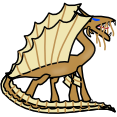The illithid reproductive cycle (as of 3.5—I don't know if 5e lore changed things) is pretty simple. Illithids make tadpoles, tadpoles infest humans (and only humans), tadpole takes over human and turns it into an illithid. But I find complex life cycles interesting, so let's see if I can't add some interesting detail.
Illithid larvae are much smaller, small enough to fit a couple in the palm of your hand. They latch onto humanoids, burrowing in and eventually making their way to the brain stem. (If an adult is implanting the larva, the process is quick and causes minimal injury, but if it has to burrow from the leg or something, the process is slow, painful, and causes serious internal injuries.) Once there, essentially it disconnects the majority of the victim's brain from the parts controlling its core biological functions, before connecting to the brain stem itself and taking control. For its first days, the larva's host stumbles about animalistically, slowly gaining the skills, memories, and knowledge of its host as it extends roots through the (still-living) brain of its host.
Over the next few years, the larva eats, assimilates, and replaces the host's nervous system. Meanwhile, the host is under its control; these larva-hosts are often used as spies or agents by the illithids. Eventually, the larva (now stretched across the host's entire body) begins to metamorphose; its host becomes ill as its nonessential tissues are consumed, with the larva using the illness as an excuse to retreat to less-observed areas "in search of a cure". Eventually, the metamorphosing illithid decides its host has no further use and begins consuming vital organs, using the host's corpse as a cocoon and energy supply to finish its transformation into an illithid nymph.
The illithid nymph looks much like an adult illithid, aside from its proportions (being far skinnier than should be possible for a humanoid) and its lack of fingers or toes. The nymph attempts to locate either an illithid community it can join (usually the one it was spying for, if it was a spy) or a small, isolated group of humanoids it can prey on. Initially, it feeds on the flesh of its prey as well as brains, enabling its frame to fill with muscle as it reaches maturity; once it has reached its adult mass, however, it can subsist almost entirely on brains.
And if you're fond of alternation of generations or what are formally defined as complex life cycles, you could add an extra step or two.
For instance, perhaps mature illithids don't produce illithid larvae themselves. Instead, when they mate, one or more of their tentacles develop a growth at its base before separating from their face. This tentacle develops into a creature that looks like a mixture of sea snake, worm, and severed tentacle; I'll call it an "eelithid" for now. The eelithid may be kept as a pet by its "parents," put in a communal pool, or cast out into the wilds. Regardless, this creature has its own ecology, psionic powers, etc, and it produces the illithid larvae.
Or perhaps there are extra steps, possible drawing in other species of tentacley aberrations. Perhaps the eelithids grow up into ropers, gricks, grells, or something like that. As an example: The eelithids grow up into gricks, and the gricks come together into a great mass to form an Elder-Brain like creature that spawns grells, which in turn implant people with illithid larvae.
If you really wanted to screw with D&D lore, you could make aboleths or something like that the mature form of elder brains. On the other hand, you could also have aboleths be larval elder brains, just needing some kind of psionic catalyst to become a being of pure cerebrum, able to see the future as clearly as it once saw the past.
Overall...between the infiltration opportunities presented by illithids having a yeerk-like larval form, the possibility of a big conspiracy where all the different species of aberration are secretly working together, and the implied plot hooks involved in turning an ancient, powerful monster into a new type of even stronger monster...there's gotta be something here you can use.
View Single Post
Thread: Random Lore Ideas
-
2019-04-17, 04:04 PM (ISO 8601)Ogre in the Playground


- Join Date
- May 2009
- Location
- In a castle under the sea
- Gender

 Re: Random Lore Ideas
Re: Random Lore Ideas



 Reply With Quote
Reply With Quote